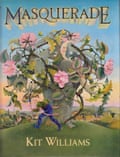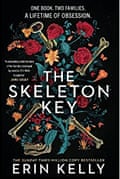At 4am, Gregg Donnenfeld sits bolt upright in bed. Finding his pen and notepad in the dark, he jots down the words “Roman numerals in artwork = Caesar cipher?” before going back to sleep.
Donnenfeld is a lawyer who lives in upstate New York with his wife and daughters. Instead of gold doubloons or pieces of eight, he’s hunting a token worth $10,000 (£8,000), and the treasure map is not a tattered parchment, but a children’s book filled with simple, bright illustrations.
Xavier Marx and the Missing Masterpieces by Hilary Genga and Sean Cronin is the latest in a long line of treasure hunt picture books. The eponymous Xavier becomes embroiled in an art heist on a school trip. Visual and verbal clues point to a physical location where a token – the nature and appearance of which is itself hidden in the book – can be presented to the authors and exchanged for the prize money.
Donnenfeld is one of many for whom the quest has become an obsession. “I have a separate Word doc devoted to each page and image of the book with tons of notes. There’s one image that my kids believe is a numeric code. We have 20 pages of work on that alone. We record every idea we have in real time. We don’t let the seasons stop us. If we let any time pass, someone else may beat us to it.”
In armchair treasure hunts, as such books are known, no kind of puzzle is off limits. Clues can take the form of astrological, masonic and runic symbols, anagrams, cryptic crossword questions, logic problems, historical facts and folklore. Xavier Marx, conceived and written in lockdown, draws on all of these and was intended to bring families together. “Imagination and intrigue are positive traits we tend to age out of as we grow up,” says Genga. “Children love to ask ‘Why?’ about every little thing. That’s a great mindset for treasure hunting.”
The original armchair treasure hunt is the 1979 million-seller Masquerade, by Gloucestershire artist Kit Williams. In it, the moon instructs Jack Hare to deliver a jewel to the sun. Intricate, fantastical paintings invite readers to stare into each page. When Jack Hare loses the jewel, it’s up to the readers to work out where Williams had hidden a real hand-beaten, jewel-studded golden hare. The book was a phenomenon, obsessing some hunters to the extent that it was cited in divorce proceedings. Airlines sold transatlantic Masquerade tickets; passengers were given a spade on arrival in England.

The solution was esoteric, to say the least. Lines traced from the eyes of figures (human or animal) through their hands, feet, hooves or paws, pointed to letters that revealed a master riddle: “Catherine’s long finger over shadows earth buried yellow amulet midday points the hour in light of equinox look you.” Arranged in verse, an acrostic spelled out “close by Ampthill”. From this the reader was to glean that the treasure was buried in a Bedfordshire park, under the shadow cast by Katherine’s Cross. In 1982, two physics teachers solved the riddle but before they could dig it up, someone connected to Williams had made an educated guess and claimed the treasure. This bad-faith find soured the hunt.Genga and Cronin acknowledge Xavier’s debt to Masquerade, and also cite The Secret, a book from 1982, whose clues were based on North American history. More recently, Joanna May’s The Hare on the Moon and Benjamin Brewis’s The Hidden Sun bear Williams’s influence.
Perhaps the most notorious iteration came in 2010, when antiquarian Forrest Fenn buried a treasure chest of rare and valuable artefacts in the Rocky Mountains. He hid the clues in a map and a poem at the end of his memoir, The Thrill of the Chase. It was controversial from the off, as hunters began to dig up swathes of national park. At least five men are known to have died while hunting for it, falling down crevices, losing control of rafts or simply from exposure. At the height of “Fenn Fever”, 350,000 people were said to be searching for the cache. Fenn’s home was broken into numerous times.
Dan Barbarisi, author of Chasing the Thrill, an account of the Fenn treasure hunt, says that the mindset that makes a good treasure hunter can also mean they go too far. “One needs to be obsessive, unrelenting. The prize becomes all-important and treasure hunting can cost a lot of real money.” The eventual finder, medical student Jack Stuef, has refused to give up the solution, saying the remote location in a national park is “not an appropriate place for a tourist destination”. Like Fenn, he is keen not to desecrate the landscape’s natural beauty.On the forums, Fenn followers call Stuef a fake and a cheat: he has since gone into hiding.

Obsession and clues, death and mystery: all this fed into my new novel The Skeleton Key. My book-within-a‑book is called The Golden Bones: the treasure is a jewelled skeleton, scattered and buried at seven locations. Unlike Fenn, my fictional artist calls off the search when crazed fans can’t tell their fictional quest from reality and threaten his family. One golden bone – the pelvis – remains undiscovered. In the present day, the artist decides to update and reissue The Golden Bones, and reveal the treasure’s whereabouts. But human remains are uncovered instead, and dormant obsessions resurface.
I worried that a reissued book wouldn’t catch fire now in the same way – remember, when Masquerade was published we only had three television channels and the pubs shut for the afternoon – but Barbarisi argues that much of the allure of these books comes from “connecting to a world long vanished. A treasure map is more romantic and mysterious – and uncertain – than a set of GPS coordinates on a Geocaching hunt. These books represent a time when information was genuinely hard to come by.There are those who miss that feeling of not knowing, of the difficulty of discovery and the triumph of hard-won knowledge.”
Donnenfeld isn’t one of them. His smartphone is as essential a part of his kit as food and water, with apps replacing compass, maps and even decoding ciphers. Does that ever feel like cheating? “The apps don’t ‘recognise’ ciphers,” he says. “It’s up to the human to do that. What they can do is decode them. It allows us to translate a code in a second as opposed to hours manually.” And, he adds, it’s the connection that matters – even more than the prize money itself. “I want to find the Xavier treasure, but watching my kids finding a hidden clue in artwork or coming up with a unique way of solving – that is a wonderful experience. It’s taught them about creativity, brainstorming and teamwork.”





